Dimension Shellshock is premium downloadable content for Teenage Mutant Ninja Turtles: Shredder’s Revenge, a retro arcade beat em up to which I gave a highly positive review and later included on my list of 2022’s five best indie videogames. For a small fee, it adds new features to the base videogame’s incredible tribute to the kinds of 8-bit and 16-bit adventures that helped make Leonardo, Donatello, Raphael, and Michelangelo into household names in the early 1990s.

Dimension Shellshock adds two new player characters to the original seven: Ronin samurai rabbit Miyamoto Usagi and the noble Foot Clan ninja Karai. Usagi hails from an alternate version of medieval Japan populated by anthropomorphic animals. This setting has been home to dozens of original stories in multiple mediums starring Usagi and his friends and enemies, to the point that it’s a dismissive oversimplification to describe him as a supporting character to the Ninja Turtles. Usagi is more like a guest star from another, similar series which hasn’t achieved the same popularity, but inarguably has more critical acclaim. Karai is a high-ranking member of the villainous Foot Clan, but in her most popular appearances has operated under a code of honor that sometimes finds her standing with the Ninja Turtles against their nemesis, the Shredder.
Though both Usagi and Karai have appeared in Ninja Turtles adaptations dating to the 1980s and 1990s, they have been most popular and prominent during the Nickelodeon era of the new millennium. Their addition here offers some nostalgia and fanservice to those who were not yet born in the original bout of Ninja Turtles mania to whom Shredder’s Revenge primarily caters.
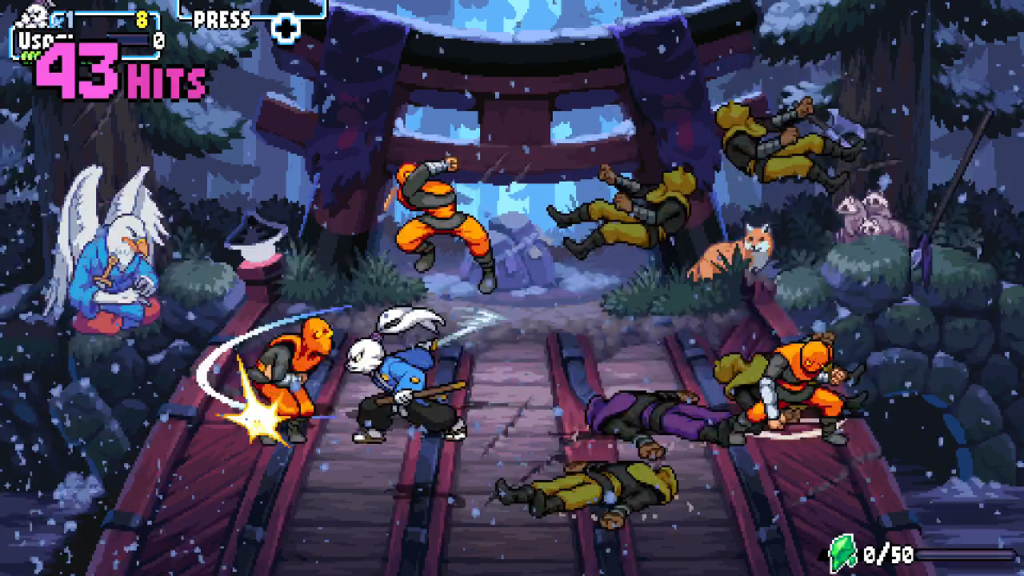
Despite being latecomers, Usagi and Karai are infused with the same incredible quality of animation which gave the original cast such distinctive personalities. Usagi moves with calm and focus. Even when running, he doesn’t seem to be in a hurry to get anywhere. In combat he uses familiar samurai discipline, his hand resting on the hilt of his sword, ready to unsheathe it at any moment to strike at an enemy, but always returning it to its sheathe afterward.
I can see that Karai is Usagi’s opposite in personality even from her neutral pose. Her face marked by a ceaseless smirk, she keeps one leg raised and prepared to make the first strike. When she is at her most frenetic she literally crackles with angry electrical energy. In my original Shredder’s Revenge review, I offered a slight criticism for defaulting April O’Neil into the “fastest but weakest” women’s category for beat em up player characters. Karai is April’s counterpoint; she stands among the highest strength rating of all the player characters, and without sacrificing her speed and range stats.
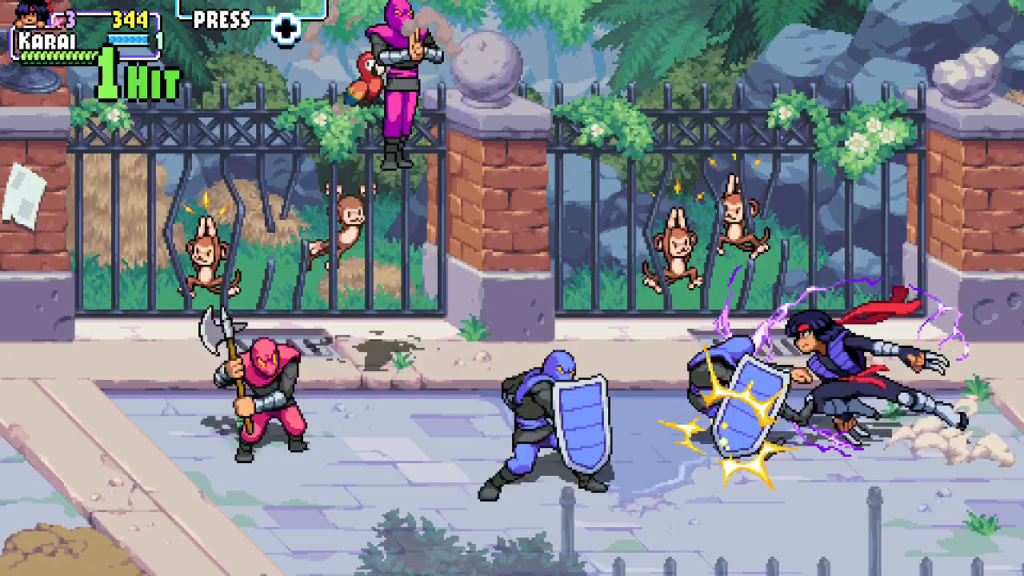
Usagi and Karai are fully functional additions to the cast and may be used in any mode as soon as the DLC is installed. Though they are omitted from the Story mode’s cutscenes, I can play through the entire campaign with them, each complete with ten Power levels to grind to max. They also receive original endings after the final boss.
While Usagi and Karai are great additions for younger fans, the real meat of Dimension Shellshock is found in the new Survival mode.
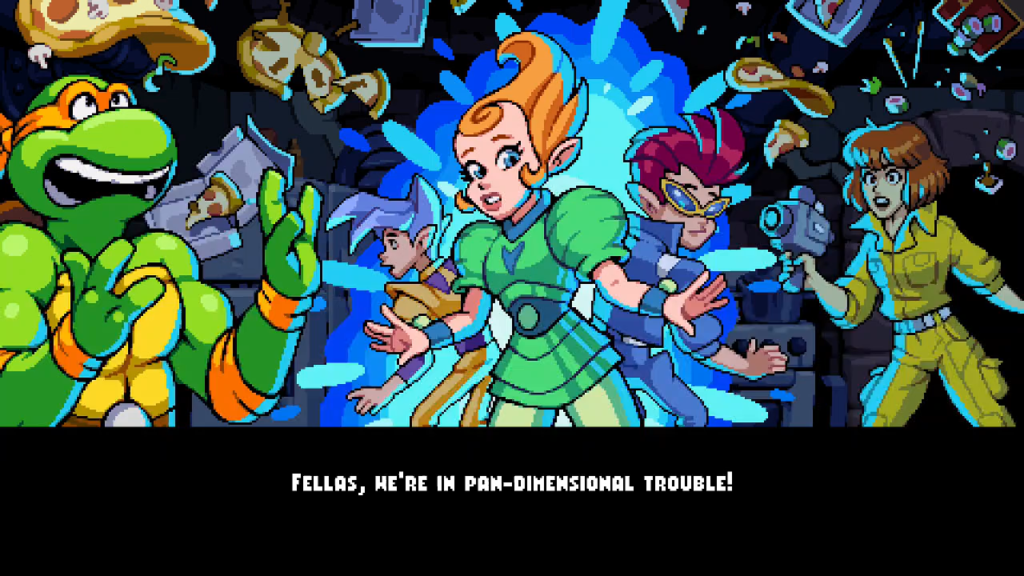
The first time I play Survival, a short cutscene plays to contextualize the mode’s spin on familiar beat em up game design. Following Shredder’s defeat in the Story mode, the Turtles and their allies—now joined by Usagi and Karai—celebrate with a pizza party in their sewer hideout. They are interrupted by a portal which brings a group of Neutrinos, technologically advanced elves who unashamedly spout dated slang while hopping between dimensions using special crystals. They explain that an alternate version of the Shredder is stealing their crystals and using them to conquer all dimensions. So soon after their first victory, the heroes have to set out on another quest to save not only their own world, but all possible worlds from a new, even more dangerous version of the Shredder.
Despite its grand setup, the Survival mode is straightforward. My chosen player character fights on a single screen arena against a wave of enemies. These waves are larger and its enemies more aggressive than those encountered in the Story and Arcade modes and it takes all my knowledge of effective tactics against every enemy type to endure each round. The task is made even more difficult by some enemies receiving improved weaponry. Foot Soldiers who previously wielded plunger-firing crossbows now fire rockets. Foot Soldiers with spears are upgraded to heavy polearms tipped with lanterns that leave damaging fires on the ground where they strike.
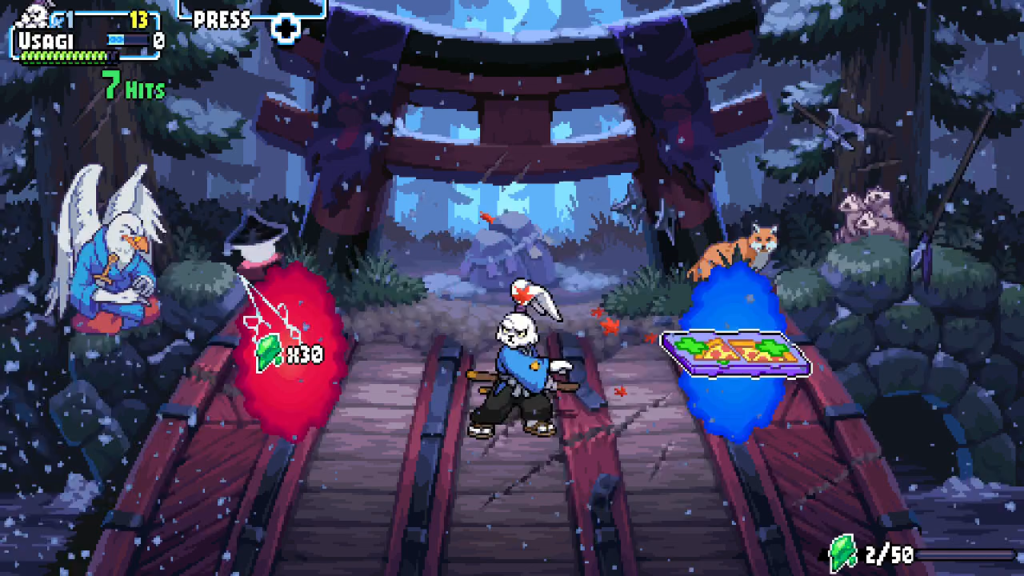
Restoring the health the player character inevitably loses to these tougher enemies is the main obstacle in surviving from round to round. Instead of a reliably placed health-restoring pizza, I have to rely on an element of random chance to keep the player character alive. After each enemy wave, two random rewards appear. Familiar pickups from the base videogame may be part of these rewards, including pizzas. More common are mutagen canisters which have radical and temporary effects on the player character. Selecting a canister may make the player character recover health when they defeat enemies, let them execute their special Ninja Powers with more regularity, or transform them into Bebop, Rocksteady, and even the Shredder himself for a time. These transformations are especially useful because, aside from offering a thrilling power trip, each also adds an extra layer of health on top of the player character’s precious default.
Survival mode is fought across five different dimensions of ascending difficulty. Each dimension is an original setting, not a remix of an area of the base game, and includes Usagi’s Edo Japan, the Neutrino’s futuristic homeworld, and a fabulous pixelated homage to the Turtles’ NES videogames called the 8-Bit Battlefield.
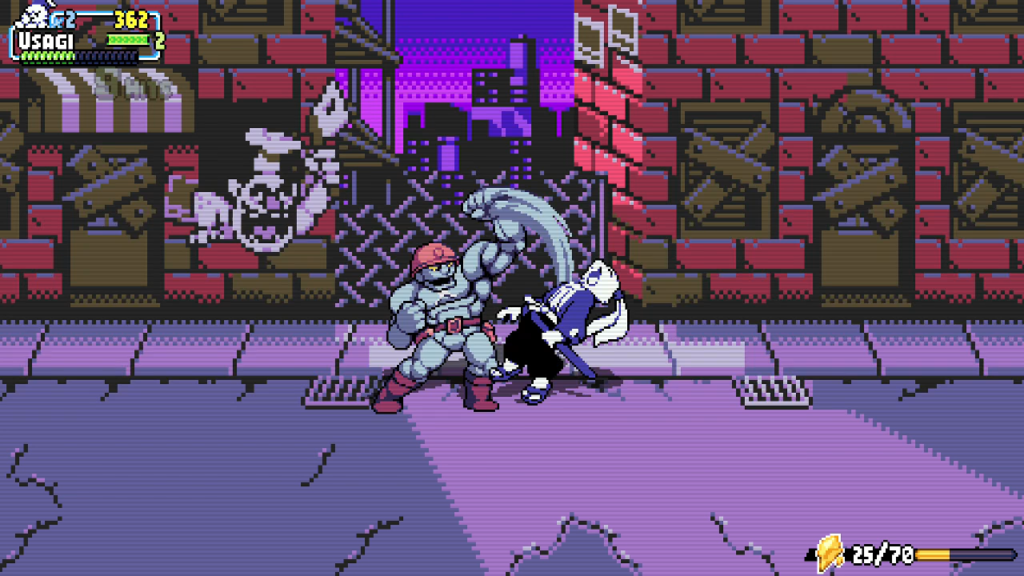
Each dimension has only two or three possible screens for the heroes to battle upon, but each is overloaded with cameos and easter eggs that will delight diehard fans. Hothead and Al’falqa lounge beside a river in Edo Japan. Mona Lisa, Carter, Zack, and Irma are menaced by Mutagen Man and Antrax in the background of a blighted world where Shredder’s plans led to his victory. Appropriately pixelated imaginings of Tattoo and Pizzaface leer at the combatants on the 8-Bit Battlefield.
The most visually impressive dimension is Mirage, an homage to the black-and-white indie comics where the Teenage Mutant Ninja Turtles first appeared. Each screen is divided into panels as though it is a page from a comic book. The heroes battle in the largest panels while artfully exaggerated closeups of their enemies’ faces scowl at them from smaller panels at the screen’s edges. A red-eyed visage of Shredder looking down on the Mirage battlefield is the most memorable image in all of Dimension Shellshock, his expression changing subtly from delight to frustration as the battle unfolds.
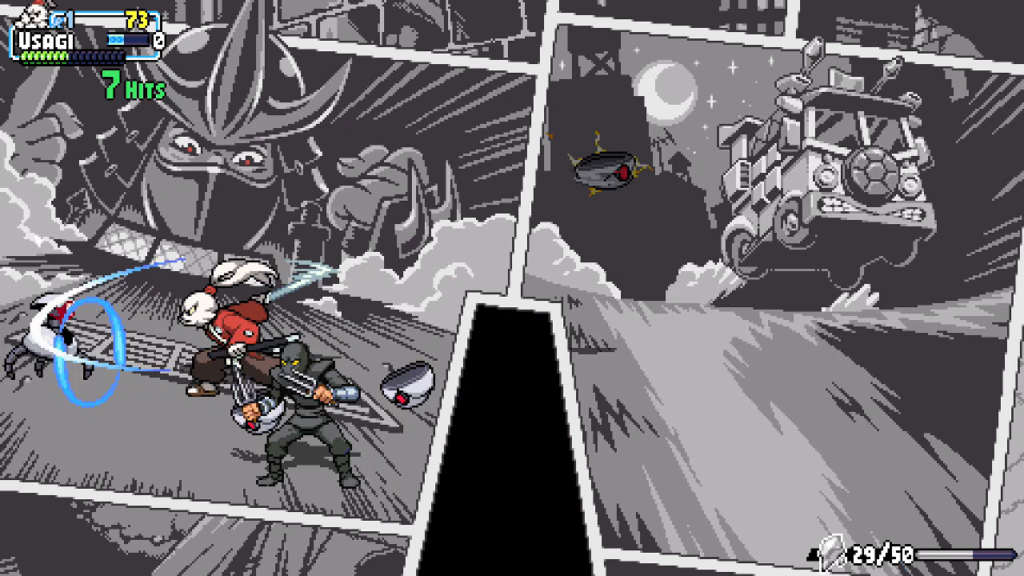
I progress through each dimension by collecting crystal fragments. When enough are collected, they assemble into a complete crystal and the player character is transported to the next dimension. If I help them survive long enough to assemble five crystals, the mode culminates in a sixth dimension where the player character faces off with a new, more challenging boss encounter against the Shredder.
Crystal fragments drop in limited quantities from defeated enemies, but I obtain most of them among the possible rewards for completing a wave of enemies. Scattering crystal fragments among these rewards creates a precarious choice: I can choose a mutagen canister that temporarily increases the player character’s power, a health-restoring pizza, or crystal fragments which take the heroes a step closer to the next dimension. But I cannot choose all three at once. The hard decisions I make between waves and the luck which provides them has as much a bearing on my overall success as my skill.
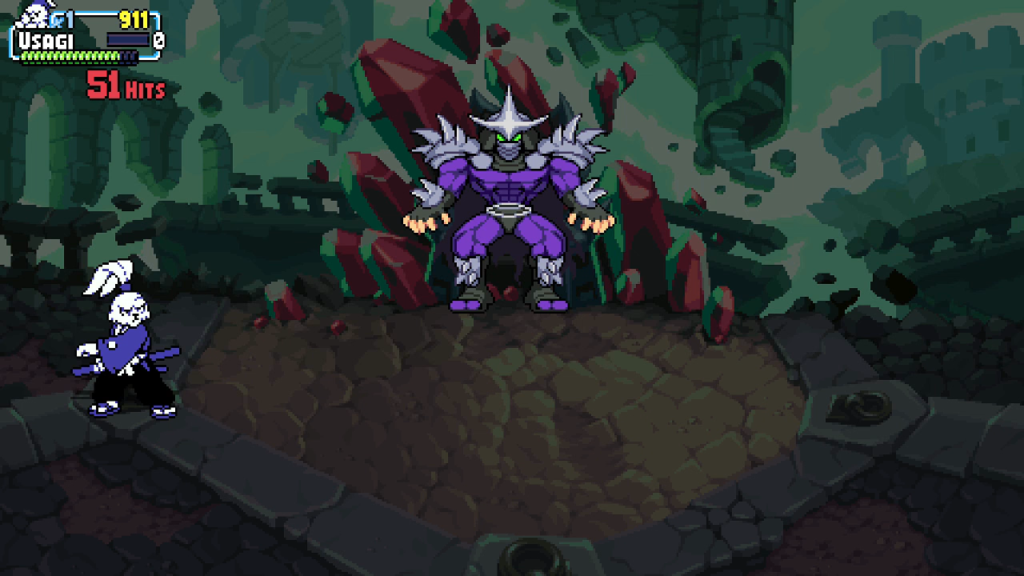
Survival mode is difficult, especially to start out, but completing crystals provides an additional leg up. Whether I make it to the Shredder’s dimension or not, any crystals I successfully complete are added to a total which persists between attempts. Beginning the Survival mode with Usagi puts him at the same statistics as a fresh character in Story mode. Completing crystals with him earns perks like an extended health meter, a second and third Ninja Power meter, and even an extra life. Once a few of these upgrades have been earned, punishments from mistakes feel less severe and making it all the way to the Shredder becomes more reasonable.
Accumulating crystals to improve each player character’s statistics is a grind, and a perhaps unwelcome one. This is even the same complaint I had in my original review of Shredder’s Revenge. Characters are improved individually, not as a whole, so if I want to play as Karai after earning a few dozen crystals with Usagi, I find myself tumbling backwards to a difficult beginning. If a friend joins me and wants to play as Splinter, they too begin at the ground floor and we have to grind together for several hours to catch them up.
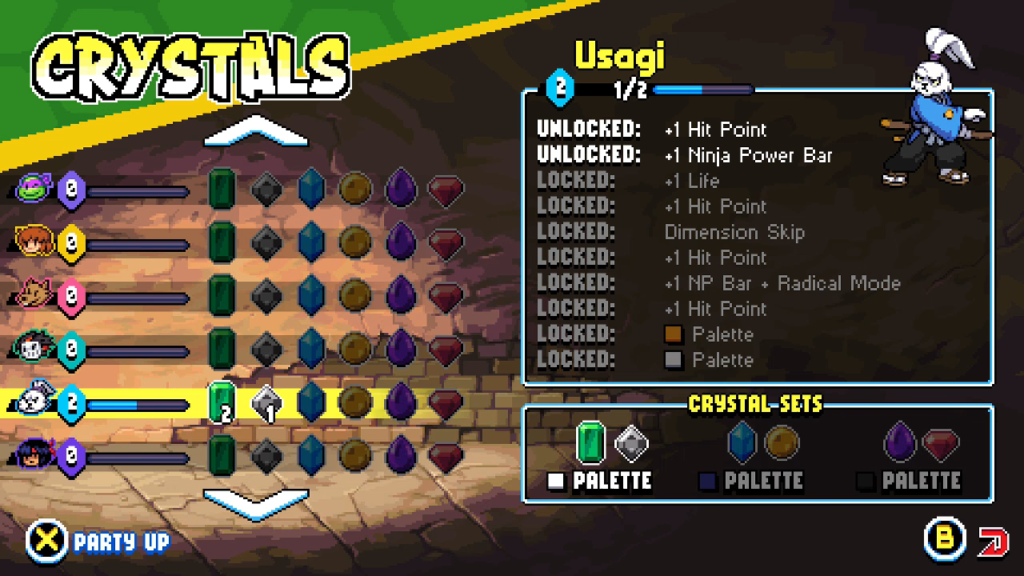
Not only are character improvements exclusive to themselves, they don’t even carry over between Story and Survival modes. My April is at the maximum Level 10 in the Story mode, but is back to her weakest self in Survival. The new Survival mode takes the grind which was my biggest complaint about Shredder’s Revenge and doubles down on it in Dimension Shellshock.
Some may see the grind as a boon. Getting every character to maximum power levels in both the Story and Survival modes is a significant undertaking, stretching a campaign and a few challenge modes that last a few hours each into an experience that takes several dozen hours to completely conquer. For me, with plenty of other videogames to capture my attention and regarding Shredder’s Revenge mostly as a party videogame to enjoy with friends, it only makes enjoying it with those friends a bigger obstacle.
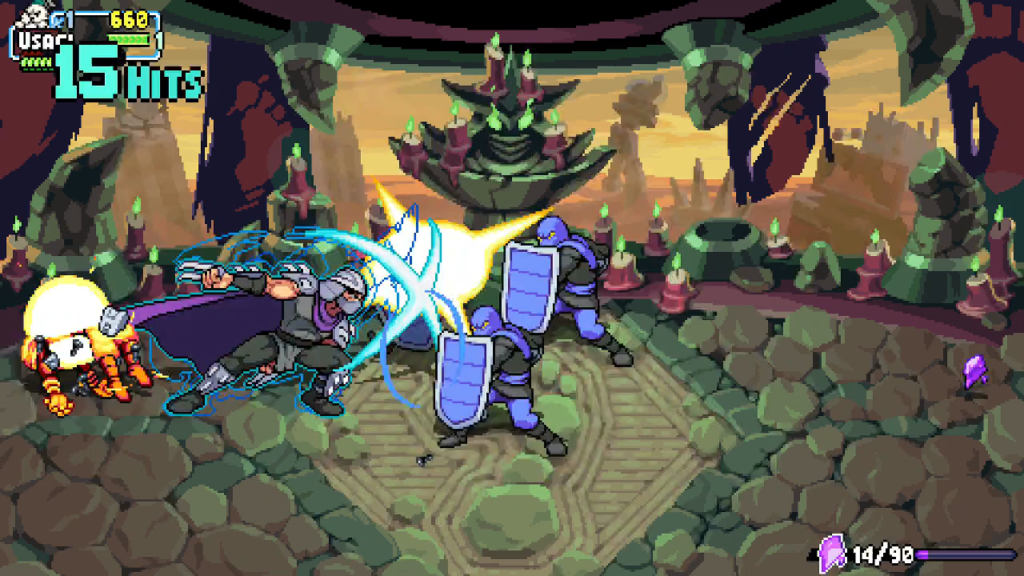
Dimension Shellshock is a fair addition to the original Shredder’s Revenge. The two new characters are nice and the Survival mode adds a significant and challenging new mode to a videogame that previously only had its narrative-driven campaign to keep me occupied. Everything that was great about Shredder’s Revenge is still great here. But it also compounds the same mistakes, and for that reason I must be a little more critical. Dimension Shellshock is a fun addition to a fantastic videogame if you can accept the grind.